I used to give a couple of talks about Bronte clothing and artifacts and do occasional work both for the Parsonage and also theatres (doing meet and greet ) I try to always well research any gowns I make for either those or other Bronte work but I also found that accurate gowns are not always considered accurate by the public unfamilar with fahsion in the 1830s to 1850s , so I thought it would be useful for those who may be interested or who need to replicate a gown for any reason if I show my background research and any relevant images as they would help shed light on how the Bronte’s and indeed other Victorian poorer middle class girls and ladies dressed.I have spent long periods of time in most of the outfits ,many I have worn in Haworth for hours ,some in the parsonage and several on the moors .I also performed some typical daily chores in several to work out if they were likely to have been viable as day dresses.
I hope it proves fairly easy to read I have worked on it for several weeks and it became a little disjointed I have tried to sharpen up the post but theres no easy way to list all the items of clothing in the Bronte collection.
Only items marked as Bronte clothing are from the Parsonage archives and collections the other images are from museum sites or taken by my Husband or myself.
First for anyone who wants to recreate a Bronte gown for theatre or work ,this is by far the easiest.Its an Emily Bronte gown.(the choker was an addition for filming but very like one worn by Anne)
Its based on this portrait.Which is generally accepted to be Emily though its been suggested it is Anne .(Arthur Bell Nicholls claimed this was Emily so to me that seems to be an infalliable ID)
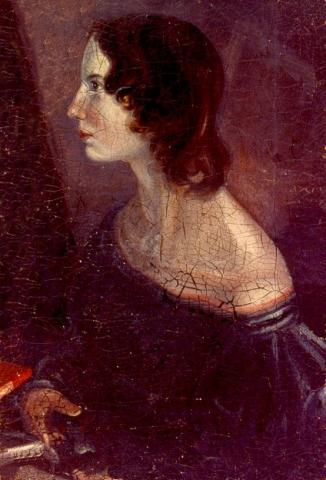
The dress was made for a young friend to wear for some filming and as I only had a couple of days I used the cheats version I give instructions for elsewhere and recovered a bought boned bodice .Its probably got a narrow hop under it as that would be the easiest for filming and safest around delicate objects in the parsonage. Anything else worn for a long time outside would have lost its shape if it had rained or been windy ,so it’s just not feasible when you dont have time for costume changes and when absolute autheticity isn’t essential is not worth the risks. The filming for for some pretty looking background shots so it wanst important. But its not accurate they didnt exist until much later,I normally wear exact undergarments .The gowns an early 1830s style gown based on the portrait above. Which is probably from the lost gun group portrait.
 In the Engraving Emily is shown wearing a little chemisett or possibly a high necked chemise however in the actual remaining fragament she isnt wearing anything above the gowns neckline .Contrast Emilys portrait with others from the same few years
In the Engraving Emily is shown wearing a little chemisett or possibly a high necked chemise however in the actual remaining fragament she isnt wearing anything above the gowns neckline .Contrast Emilys portrait with others from the same few years
The gown in the portrait did remind me slightly of this portrait of Augusta Leigh Byrons half sister .
The dress is suprisingly low necked and doesnt appear to show a chemise though the gun group image itself does so perhaps either the paints changed and lost the gauzy details ,though thats unlilely .Or Branwell changed the neckline to make it look more like a classical portrait or perhaps Emily left off her chemise to pose or the dress had a pelerine that Emily removed while Branwell painted her ,all are rather radical for a respectable young lady.
Most 1830s gowns are wide necked but the necklines are much higher
In addition they would usualy be worn with a collar or pelerine over them at least outside or when recieving company,The image below shows the above gown with a pelerine
(V and A online collections archive)
I made my own version of the gown replicating the details on the sleeves etc and using a fabric with the same palette.The image below is of an employee and used by the kind permission of Mark Davis Photography and the Bronte Parsonage Museum.
Before considering an actual museum standard gown ,for anyone wanting childrens outfits or theatre costume ,what might be more useful is the “Everyone knows what the Bronte wore dress,”though its unlikey they ever actualy wore gowns and collars identical to the ones in the Pillar portrait the image is the most well known and therefore a gown based on it will immediatly be equated with the sisters without the viewer knowing about Victorian clothing.They are also much easier to make than the other gowns ,you can easily make them using my cheats guide elsewhere on the blog .
I decided to make my “Everyone knows what the Bronte’s wore dress in roughly the style and with a similare collar to the dresses in the portrait
I made both a Brown shot taffeta version and burgandy mat silk version
The key element is the collar .You can add a wide collar over more or less any basic gown.Both mine are lower waisted than the portrait gowns ,but again I found that people assumed the typical late 1840s and early 1850s lower waists were what the Brontes wore.
The gowns in the portrait are fine for the era as are mine but the collars on Emily and Anne are quite odd ,possibly because they were actualy wearing little fichus like Charlottes but Branwell prefered missing out the hard to paint translucent flounces.
The actual collars may have looked something like this one which is an antique victorian collar ,though of a later era which I adapted.The dress is an identical cut to the portrait gowns.Its very comfortable to walk and work in .I can understand why Emily preferred wide sleeves.Tight fitting sleeves restrict your arms upward movement and are incredibly hot and uncomfortable in hot weather

The dress below is from the V&A is my colour source for the red gown in the earlier photo and its collar.
The Bronte’s early dresses would have looked similar to the one above , though the sleeves and skirts are wider in the above gown than theirs may have been.
To create a more accurate gown ,its essential to get underlayers correct ,These altered radically over all the Brontes lives but especially Charlottes as she lived into the 1850s.
I needed to figure out the under layers for the 1830s dresses to make them look right.Some dresses had special petticoats and sleeve panels like the onbelow though I can’t believe they were often worn.
The bodice above is corded and the petticoat is also corded to make stick out from the body and to cut down on petticoats ,the sleeves seem to be wired though they may either boned or cordede and starched .
While I doubt the Brontes ever wore the all in one version or had their sleeves boned .I think it quite possible the Bronte’s owned corded petticoats to give their skirts fullness as these were both common and effective.They were easy and cheap to make and washable theres an extant example shown below.(It was possible to make these in other colours).I have worn a few versions which I made quickly and cheaply they are effective over ,lighter fabrics and comfortable ,I feel it likely these featured in the girls wardrobes ,especially as they are easy to get on and off if you wanted to go on the moors and didnt want to get it wet or stained by peat .
Before the hooped cage crinolines the only options for making skirts fuller where corded petticoats or the original crinoline (from which the later cage crinolines take their name ).This was a horse hair linen mix undergarment that grew in popularity after the late 1830s and up until the advent of the cage Crinoline in the 1850s.There is an example below from costume archives.
I have worn an original Victorian quilted petticoat which is similar and very hot and when wet incredibly heavy ,though marginally better than lots of petticoats and easier and faster to get in and out of .For getting about outside in Haworth it might have been a handy option and they are quite comfortable to sit on and nice insulation ,do for church etc might have been a good choice .
These were also quite common but few have survived and there are none in the Parsonage collection so I cant be certain the sisters owned any ,though I think it likely they owned something and disnt rely on lots of petticoats .I make assumptions on items not in the archives much as today you would automatically assume a woman had owned a bra.We dont hear these recorded in costume inventories for people such as Princess Diana ,but clearly she wore them.
.The only remaining option for women who wanted to have the fashionable full skirted look was lots of petticoats up to six which are heavy and very cumbersome..Its clear the Brontes did own petticoats as their absence on Emily is mentioned .They are incidently real pain in the neck to wash and iron and starch even with modern appliances, it takes me an entire day ,using a modern washing machine ,a tumble dryer ,spray starch and a modern iron ,the petticoats take up an entire room during this process and several drawers when not being worn .I have never yet succeeded in getting peat stains from a petticoat so I strongly suspect the Brontes had outdoor clothes stashed in thd back kitchen for moorland walks.I also feel they must have had one or both of the above options .These are also bulky but could be stored more easily .Putting on layers of petticoats is time consuming and restricts your legs ,it also makes your middle back ache after a while if you stood .When wet they become even more restrictive ,they cling round your legs and ankles and weigh a huge amount once really soaked .
In petticoats ,a wool dress ,winter bonnet and a wool cloak I weighed over a stone more than normal.
As a final observation ,I was asked to read parts of Jane Erye in the parsonage ,some walking round the living room table, doing that in a gown with enough petticoats to make it fashionably wide was scary considering the priceless treasures within reach of my skirts,but also the proximity of the fire was very noticeable,.having three young women in the room would make it even more of a hazard, especially at night with candles or lamps also lit.Patrick’s concerns about fire were entirely reasonable.He had buried children who died from their clothing setting on fire and it wasnt an unheard of cause of death,possibly accidents related to clothing fires were as high as road traffic accidents are today.I was always worried about it and I know of one reenactor who was burned because her skirts caught fire.
My wet dresses skirts also used to cut a swath of damp dirty mark’s on floors and along any wall I accidentally brushed against.
We only have a few items of Bronte under garments.
This corset said to be Charlotte’s and which looks purgatorial and is boned with whalebone ,its quite an early one as it also has a busk or wide from boning panel down the center front.This was designed to shape the figure slightly and to take the weight of all the other layers and stop the petticoasts digging into your waist.It was always worn over a chemise.I have a post on this elsewhere as I was lucky enough to see it “in the flesh”
The under layers for the Bronte’s in the 1830s would be very much like this from a fashion museum,this corset is corded not boned but is otherwise very simialre to the one at the parsonage
You would always wear a chemise as it stopped your corset chaffing your skin, this chemise is at the parsonage and said to be Charlotte’s(though I believe its also been attributed to Emily ).The owner isnt really relevant as its a pretty standard chemise.
It’s unlikely the Bronte’s wore bloomers or anything other than chemises under their other layers, it wasn’t fashionable to wear them until wide skirts became fashionable in the very late 1840s early 1850s and only common once the cage Crinoline which could sometimes blow about in the wind .But even then they were almost always divided leg bloomers,, the legs where sewn separately sometimes only linked with a drawstring onto a waist band or gathered onto a waistband leaving more or less complete gap in the middle (,, this is reason Victorian ladies managed to go to the bathroom).
Also at the parsonage are a couple of items described under bodices which I have never seen any up close but from photos I assume they are corset covers.The one below is an good example of one of these pretty little items and the neckline trim was probably designed to show above a gown neckline.

Corset covers where little blouse like undergarments that went over corsets to protect your dress from the corset.Alternativly they went under gossamer thin gowns in much the same way as regency gowns often had gauzy overlayers and a simple plain undergown.Charlotte owned at least one barage gown,I have seen fragments of a polka dot one and theres a mention of it in regard to the Thackery dinner , so its possible this belonged under that
I think this is the same item and is almost certainly a corset cover as I have owned an almost identical one
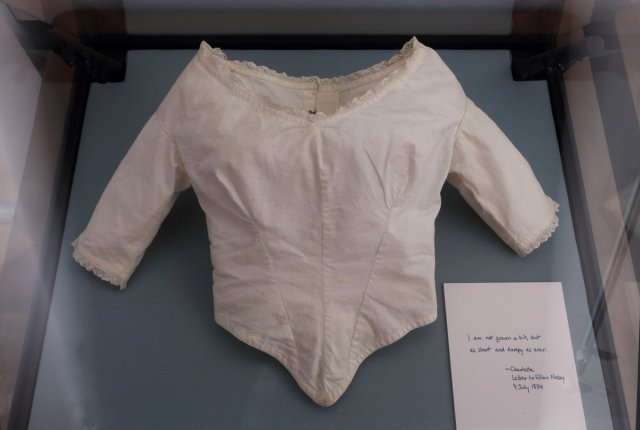
With regard to the under gown and over gown theory ,its interesting to contrast two portraits of Ann,partly for their costume details but also because it gives insight into Patrick as a father.
This dress seemed a very similar colour and waistline to those in the Pillar portrait and I discovred a dress in a similare stlye and colour in the Met Museum online archives.
However Anns gown seems to have been part of an ensemble of under and over gown rather than a simple day gown.It mak even have had short sleeves with removable longer sleeves
These overgowns were quite expensive ,perhaps the fabric was culled from Aunt Branwells wardrobe or Mrs Brontes or perhaps Patrick Bronte treated his daughter to an expensive pretty but not particulary pratical gown as a birthday treat.
Certainly the portrait contradicts the idea that Patrick was auster and forced his children to wear only functional and practial clothing one thing a net or gauze overgown definatly isnt is practical especialy in a stone flagged Parsonage full of pets at the top of a mucky road on the edge of the Yorkshire moors.
For the smaller items of Bronte clothing I used the gun group portrait again
there are several chemisettes , modesty panels and under sleeves /cuffs at the Parsonage
Chemisettes are little sleeveless half blouses that either button up the front or tie under your arms and create the little frilled tops in the gun portrait, these are a set of under sleeves and chemisette from the 1850s, but the 1830s and 40s chemisettes are the same style,.The fuller engagment type under sleeves only became fashionable in the 1840s /50s but its possible Anne short sleeved gown had similar sleeves to those above to transform it into suitable day wear.
The Brontes and colour.
I needed next to find a suitable colour for an actual historicaly accurate gown. I checked parsonage records and found Brown is a recurring colour for dress fragments and bonnets. Silk is very common in fabric scraps from Bronte dresses ,Mr Bronte felt cotton a fire hazard.(though there are cotton dress fragments) Both silk and wool references are found in letters in the archives or reporduced elsewhere .Charlotte wore shot silks occasionally so I bought Brown shot faux silk taffeta for one gown
The Brown fabrics and accessories are mostly recorded as Charlotte’s but some non specified, while shawls are often cream and brown and there is a parasol that’s fawn and an umbrella (see below) that’s brown. In addition threes fawn ribbons and brown fringes and trims.I think its fairly safe to assume therefore that Brown was a popular colour ,possibly because it didnt show peat or mud stains ,possibly because it was a colour governesses and teachers could wear.
The other dresses where more of a problem ,I bought fabric for a replica summer dress modelled as closely as possible on a dress in the collection.I have seen this gown up close and its beautiful a fine paisley print and quite a thin fabric .It didnt look worn so I assume it was either /and a trousseau or a London gown.
.For my dress a choose a fabric as similar as possible to the complex paisley floral fabric and based on parsonage records of other fabrics.
Heres my dress full length
and the front
For my other planned dresses, choosing another colour was hard as so many featured in the fabrics in the catalogue and in letters. Green featured both in accessories and dresses fragments of Charlotte’s trousseau gown where deep green spots on what looked light pale lilac grey.
, While there is a fragment of a blue floral dress.(possibly of the same fabric as the disputed “Thackery gown)
. A mauve, cream, pink and green dress exists in the catalogue but it’s not specified if it’s a Bronte gown with proven providence .Its looks a later gown 1840s or possibly 50s but it’s quite hard to tell. The image is not very good quality . Patterning on Bronte gowns is common there are few if any plain unpatented or textured gown fragments.
These and other Bronte items are all from the Bronte online archives.
Alongside brown pink features suprisingly often ,at least as patterning and trimmings Charlotte mentions buying a pink bonnet ,there seem to be pink bows and pink trims There’s also a pink dress seen in photos on a model The left hand” dress “maybe the pink wrap / dressing gown.
I have seen the pink wrapper dress up close and had a chance to examine it,its mention elsewhere on my blogThe pink dress is badly faded as it was in the distant past displayed in sunlight (long before the current Parsonage staffs time)The unfaded parts are a quite bright pink not pale baby pink
Wrapper gowns were a form of semi dress,they were not exactly equivilent to our dressing gowns because they were a kind of at home informal wear in a way that a nightdress and dressing gown are not,but they were not everyday public wear either .
I did think of trying to find an embroidered cream fabric for my dresses , Charlotte talks of a “sort of fawn coloured silk; in a letter about her wedding dress and a replica is show here. She was described as looking like a snowdrop and I have seen the fabric described as embrioded.Its hard to see details in this image.
However Embroidered cream silk proved out of my budget so I rechecked the archives, another complete dress at the parsonage is blue-green floral cotton ,this is the so called Thackery dress,Though its extreemly unlikey Charlotte would have worn such a dress to a fashionable event with one of her heros.Though the Brontes first visit is often quoted in regard to Charlottes outfits,this was because they had travelled overnight and quickly on bussiness ,I think most of us would be hard presssed to put together suitable outfits for the Opera and visiting fashionable homes from an overnight bag .Charlotte is very keen on being in fashionable ,though not showy outfits .She would not have worn a cotton day dress .Barage is mentioned orginally as the fabric of her gown and as a lot of pieces of an identical barage fabric exist in the Bronte collection it seems much more likely the original description was correct .
Barage is a gauzy type fabric,this is from the collection at the parsonage ,several exist all labelled as parts on a dress belonging to Charlotte.
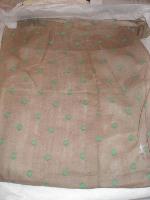
A dress of Barege would look like this,this is from a museum in the USA (In sacromentos living history museum) but the same fashion as those seen in the UK

https://the-cup-that-cheers.blogspot.com/2015/05/back-to-costuming-mid-victorian-sheer.html
Its easy to see how a gown like this would fit over the little under bodice in the parsonage collections .It would also be more suitable for a fashionable event than the dress in question,which is very trim and pretty in a deep liberty style print with tight sleeves, full skirt and high neck.But clearly a day gown.
To widen my options for my own outfits are neither fabrics are suitable for heavy wear or for outside in muddy streets, I checked letters and paper and Grey reappears time after time both in fabric and accessories.Probably also because it was a colour acceptable for governesses or teachers and also didnt show dirt easily.
Ann mentions buying grey silk in a diary paper and many lilac or other dresses and fragments at the parsonage have grey tones in them and most are probably orginal colours rather than from time changing the colours so I decided on a grey dress and bought grey silk roughly the shade as that above.
Some people commented on Charlotte being in mourning when she visited London so I also decided to make a black dress as I needed an 1850s mourning gown for my Victorian talks and decided I may as well make one compatible with the years 1847 to 1850
Mourning was supposed to be plain so the comments about Charlotte from visits to London after her sisters death are also misleading,she is described as in “Deep mourning ” which is a specific reference to clothing ,deepest mourning meant that you didnt wear trimmings ,you fabric had to be mat and the style simple ,Any collars etc would be black .There are black veils in the parsonage collection which perhaps came from this time.
To return to my dresses .
I had been considering a version of a brown Bronte dress at the parsonage dated 1835 to 40
Unfortunately. I have not seen it on display recently and as I had made a very detailed 1830s Bronte gown last year for some promotional work in Haworth.
(Though I did later see the gown which is much prettier in the flesh than in the photo ,it still wasnt an option for my own replicas.)I had already made some detailed gowns and as they are incredibly time consuming I decided on something easier.
, I wanted to make a cooler and simpler dress for this summer’s work without spending the weeks on it that my other dress had taken.My old late 1830s dress above was reminiscent of the Parsonage dress it’s in dark colours though in my case green faux silk .The style is a mid to late 1830s and a museum standard replica . There are pin tucks on the hem and cuffs plus on the pelerine and almost ubiquitous smocking on the sleeves
Sources for my green dress where among others, the image below wich is From Manchester’s costume museum site.
I particularly liked this gown as Emily is mentioned as having chosen a rather flashy fabric for her dress on one trip” white stuff patterned with thunder and with lighting, in purple splashes (p213 project Guttenberg online edition, Mrs Robinson, based on Ellen Nusseys remembrances.)
To go with the dress I made a couple of bonnets, the basic shaped bases were bought and I recovered them. I have quite a few bonnets as buying bonnets seems to have been the Bronte’s equivalent of modern women buying shoes, whenever they go anywhere you usually hear about bonnet shopping in letters.
Theres a large collection of bonnets in the Parsonage from many eras
The parsonage usually at least one is on display, Several seem to be fawn or light brown with brown ribbons which seems to support the idea of Brown as a fall back colour for Bronte clothing.With regard to the so called Bronte photograph I think its worth mentioning theres not a single hat in the parsonage collection that has a provence linking it to the Brontes,nor anything that would even remotly resemble the outfits in the photograph.But there are a lot of bonnets, mentions or bonnets and also trims that may well be from bonnets and veils .In addition had the now fashion aware Charlotte choosen to wear a hat I am certain it would have been mentioned and that one would have surfaced .Hats were easily passed along as gifts and less likely to get damaged than bonnets ,yet we have lots of bonnets.The so called hat mentioned in regard to a portrait sitting has actually a hair piece the painter mistook for a hat.
I wanted my new dress to have Gigot sleeves or Leg of Mutton sleeves as they are also called but as the fabric was not stiff enough for the standard gigot cut sleeves and I couldn’t fashion them entirely out of one piece of fabric as they often are in originals, I compromised and used another style that made the leg of mutton sleeves in two parts.
I wanted full sleeves because Emily is known to have worn them well after they went out of fashion ,,”Emily’s pet whim in and out of Fashion” Mrs Robinson calls them.Leylands biography mentions that she wore them even in Brussels .I can undertsand this as htey are much more comfortable than the tighter fitting later sleeve designs and also less restrictive ,the cut of later gowns ,plus the tighter sleeves makes them very restrictive .
The fabric I used was the same as my other Charlotte dress .The white fabric seemed acceptable as its similar to a fragment of one of Charlotte’s dresses from the Parsonage which is described as “white cotton muslin with colour flowers and leaves in red pink yellow green, brown and blue” .(d148 catalogue no image
I also bought an early Victorian cloak, though I think it’s had the buttons replaced
While I made a futher cloak

and I already owned a long wool cloak

Also in regard to the so called Bronte photograph ,Cloaks were by far the normal forom of outer wear .If there was a shorter version it would probably be something simialr to this (later but adapted ) mantle

I made several items of Bronte clothing so I thought they might be interesting to see as often the fabrics ,accesories etc are based on the archives
Bonnet ,mitten and shawl ,the necklace is a fake jet mounring necklace in a style seen in other necklaces at the parsonage
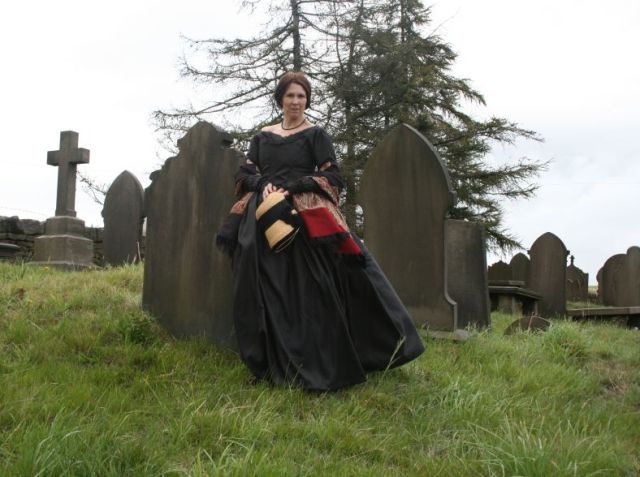
shawl again

The image below is compliments of Mark Davis ,taken at the event which was part of the pre release showing of Jane Eyre,The shawl ,bonnet ,gown ,necklance and parasole are all accurate I am also wearing several starched petticoats so the dress hangs and is as bulky as an gown would have been ,I only added some hair ornaments to give the outfit a more evening style feel

Bonnet and gown ,,and scenery

bonnet and gown and underlayers,this is scarbough beach,where the reunion in Agnes Grey takes place


Gown colour ,shawl ,bonnet and scenery

shawl ,but for anyone who hasnt seen a Newfloundland this is what Rochesters dog would have been like

Not the bow ,but collar ,gown , shawl ,boots

gown and reticule (little handbag)

With an unaccurate hoop ,but the same effect can be created with petticoats (I was only doing a few minutes enroute eleswhere that day ) I thought some parsonage photos might be nice

Photo by kind permisson of Mark Davis,Mt Brontes study in an outfit of the kind which would have been worn my Mrs Bronte

My young friend Victoria in an Emily outfit


I should have a highter neckline ,but this was supposed to be an unfilmed break in some filming ,I look much more demure swathed in the cloak as above

From a brief trip on the moor for promotional photos for the Mrs Bronte day,,my dress got that mucky in just a few hundred yards

Cloak ,bonnet and howling gale all authentic

There should be a cloak and a lace collar or a pelerine and my hairs a mess but I liked this photo and the gown layers and bonnet are correct ,I thought some of our unused after shoot photos might be nice

because it occured to me that the Brontes didnt always have public ready outfits on

Below is Scarbough beach after out photos were finished


Bonnet ,cape /cloak ,gown and umbrella

bonnet and cloak

Dress,collar and cuffs

The shawl

References
Francis Leyland’s biography
Mrs Robinson’s biography
Charlotte’s letters
Ann’s Diary paper.
Items referred to and found in the parsonage collection online catalogue
Other items Modesty vest
Bust 900m going away dress waist 650 mm
Bust 750 mm on an earlier dress.
Brown flat dress bust 880 mm,
2nd dress bust 690 m
Shawls, one, Brown cream and black
One green white and gold silk
One belonging to charlotte red shawl silk wool mix with flower sprays in red pink green-blue and yellow
One paisley shawl dark red
One paisley shawl with reds green orange and brown etc on a cream background
One of Charlotte’s shawls fawn mauve and cream woven in a chequered pattern.
One of charlotte shawls e cream wool with pink, purple and white bands
Another in similar colours
Another in white yellow and plum with a pale background
Another red and gold paisley shawl
Another paisley shawl in white blue tan pink and black on a pale background
Another cream with a brown and black border
Plain cream lawn shawl, pelerine?
Black oblong shawl look like lace? Mourning shawl/
Fan of cream silk silver pink and green with sequins.
Parasols,
2 Black silk with fringe
Brown silk
Paisley silk parasol, gold cream pink red
Charlotte white with black stripes
Black cloth ankle boots of fabric with leather soles and trim and wooden heels,
Pretty little pork pie hat of silk lace and velvet pale coloured 1854?
Lace night-cap.
Lace fichu
Black satin slippers with ties charlotte.
Leather mules
Random Dress measurements, I used these to judge comparative fullness for the skirts of dress I made,
Charlotte’s going away dress
Bust 900 mm
Neck to waist 410 mm
Waist 650
The muslin dress I copied
Bust 750 mm
Underarm seam 530
The unspecified brown and cream dress
Bust 880
Neck to waist 350
Underarm 390
Brown Emily? Dress
Bust 690
Neck to waist 260
The uncertain date pink dress
Bust 830
Underarm 390
D11 in catalogue
Purple dull brown dress with leg of mutton style sleeves and white pointed collar, silk
Bust 780
Underarm seam 380
Nape to waist 360
d156
Charlotte dress in a wool cotton mix
Dark rust with floral sprays in pink cream green and blue
Leg of mutton sleeves with cuffs and high waist
Skirt length 980
Skirt belonging to charlotte
Blue and white flower pattern (perhaps the same fabric as the fabric scrap)
d13
Blue and fawn cotton taffeta mix raised diamond effect pattern
Bust 800
Waist 24ins
I am not sure of the design of this it has a under and upper skirt and a stand up collar but not many other details
Possible charlotte dress
Light wool and velvet in a floral white, blue and brown,
Narrow close-fitting sleeves and mandarin collar buttons down the front
Bust 730
Nape to waist 330.
Cotton wrap
Pink red and white, flared sleeves and gathered waist d51, and with matching pink shoulder cape d52
Several chemisettes
Lawn cuffs and collars
Modesty vests
Corset










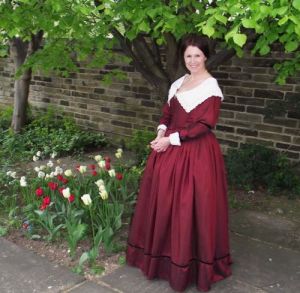









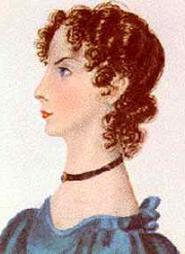

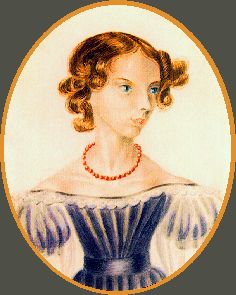























Pingback: 1840’s Maternity Dress
Wow. Stunning research and work!
Hello, thank you
Hi, can you post more windy photos with the cloak? I would love to see them
Hello thank you so much for putting all your research online for us. I have just returned from a visit to Howarth and a visit to the Parsonage. I saw the example of Emilys lightening dress used for filming and it inspired me. Your analysis on what the sisters wore is very thoughtful. Marvellous.
I hope you enjoyed visiting Haworth I used to live nearby for several decades its a beautiful place and the parsonage is excellent